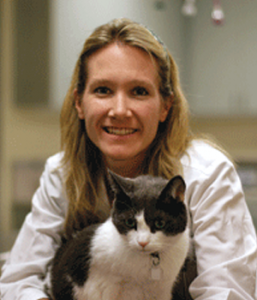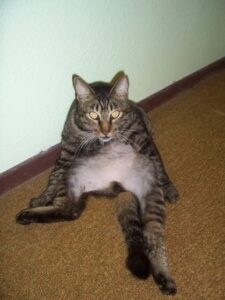-
Adopt
-
Veterinary Care
Services
Client Information
- What to Expect – Angell Boston
- Client Rights and Responsibilities
- Payments / Financial Assistance
- Pharmacy
- Client Policies
- Our Doctors
- Grief Support / Counseling
- Directions and Parking
- Helpful “How-to” Pet Care
Online Payments
Emergency: Boston
Emergency: Waltham
Poison Control Hotline
-
Programs & Resources
- Careers
-
Donate Now
 by Lisa Maciorakowski, DVM
by Lisa Maciorakowski, DVM
www.angell.org/generalmedicine
617-522-7282
The over-grooming kitty is very common, although particularly frustrating, circumstance because there is usually no quick, easy solution to the situation. The cause for over-grooming may be behavioral or medical. Behavioral over-grooming, otherwise known as “psychogenic alopecia,” is a form of stress-relief for many cats. However, this is a diagnosis of exclusion after all the potential underlying medical causes have been ruled out.
Medical causes that may lead a cat to over-groom are usually those that make the cat feel itchy. One of the most common causes is an allergy. Just like people, cats can have allergies to food, fleas, or anything else in the environment – natural or not. So if your cat suddenly starts to groom more or there are patches of missing or barbered fur (where chewed hair shafts have become stubble) to suggest he is licking or plucking more, make sure to check for fleas and look for any changes in his diet history or environment. A vet can help look for evidence of fleas, recommend flea preventatives, and discuss options for diet trials. Veterinary dermatologists can do allergy testing. Sometimes a positive response to a trial with a steroid or anti-histamine will help support the theory that the cat has an allergy as the cause for his over-grooming.
Other causes of itchiness in cats can be something infectious like skin mites and fungus (ringworm). These are less common in indoor-only cats, but not impossible. Your veterinarian can perform skin scrape procedures and fungal cultures to rule those out.
For many over-grooming cats, the act of grooming itself can cause trauma to the skin. This can sometimes be confused with primary skin lesions that erupt on the cat and then secondarily cause them to lick…which leads to the question of which came first? One example of a relatively common primary skin lesion is the eosinophillic granuloma complex. The cause of these inflammatory lesions is unknown, though it is suspected to have an allergy or immune-mediated component. These lesions can be diagnosed with a skin biopsy or otherwise by response to a steroid treatment trial. Skin biopsies can also rule out many other less common skin diseases in cats.
Regardless of the underlying cause of what is making him over-groom, the skin may or may not develop a secondary bacterial infection which sometimes needs to be treated with topical or oral antibiotics. While the skin is being treated and the source of itchiness addressed it is often advised that the cats wear an Elizabethan collar to help break the cycle of licking.
General lab work is also usually recommended to rule out any metabolic underlying causes like hyperthyroidism. Since any illness may be a source of stress to a kitty and thereby lead to over-grooming, it is important to evaluate the general health of the cat. If the focus of the over-grooming is on one particular body part, the underlying areas should be evaluated for possible discomfort such as a joint with arthritis or a bladder infection.
After all possible underlying medical causes have been ruled out, the over-grooming can be considered a behavioral issue. Psychogenic alopecia is a stress-related disorder. It is an obsessive-compulsive behavior where the cats suddenly cannot stop licking or chewing at themselves. Since grooming releases endorphins (hormones that make the cat happy), they will often partake in this pleasurable and relaxing ritual to help calm themselves.
There are endless sources of possible stressors to cats. They are especially sensitive to change, so anything new, moved, or changed in their environment could potentially be upsetting to our feline friends. Often we can’t even identify the stressor and it is important to remember that stressors are different for each individual cat. A generally chaotic home or a boring one might be a stressful environment for cats with certain personalities. Sometimes what started out as grooming to self- soothe for one particular situation can develop into OCD behavior even long after the original stressor is gone.
Cats with psychogenic alopecia will often focus on grooming or plucking out fur from their bellies, inner thighs and strips along their front legs, although they can groom anywhere. Psychogenic alopecia can occur in any cat, although it may be more likely to develop in a cat with a particularly high-strung personality. It is important to realize that many cats do this grooming when their owners are not watching and so the actual over-grooming behavior is often not noted and it can be incorrectly thought that the cat’s fur is just falling out on its own. If the over-grooming is witnessed, the cat should not be punished, as that would only create another source of stress.
It’s important to realize that grooming is normal and natural and some cats do groom a lot – and that can be normal. But we would start to become concerned when the grooming activity distracts the cat from his other daily functions (eating, playing, interacting, sleeping). Also a sign of concern would be areas of baldness, damaged or shortened fur shafts, or abnormal looking skin.
 There are a variety of ways to attempt to treat psychogenic alopecia. First, remove the stressor if possible. This may take considerable thought since it may not always be obvious (to anyone but the cat). The next most important thing is to provide plenty of environmental enrichment. This can be in the form of plenty of toys, interactive playtime, and playmates (unless the playmates are the initiating source of stress). Cats should also be provided with plenty of appropriate outlets for scratching and stretching, as well as plenty of cozy spots to rest and secret places to hide. Try to keep the cat’s day as routine as possible. Synthetic pheromones, like Feliway, which comes in a spray and diffuser form, can also be used in calming cats. It mimics the facial pheromones that cats use to mark their territory and keep calm.
There are a variety of ways to attempt to treat psychogenic alopecia. First, remove the stressor if possible. This may take considerable thought since it may not always be obvious (to anyone but the cat). The next most important thing is to provide plenty of environmental enrichment. This can be in the form of plenty of toys, interactive playtime, and playmates (unless the playmates are the initiating source of stress). Cats should also be provided with plenty of appropriate outlets for scratching and stretching, as well as plenty of cozy spots to rest and secret places to hide. Try to keep the cat’s day as routine as possible. Synthetic pheromones, like Feliway, which comes in a spray and diffuser form, can also be used in calming cats. It mimics the facial pheromones that cats use to mark their territory and keep calm.
In some extreme cases of psychogenic alopecia, anti-depressants and anti-anxiety medications can be used in conjunction with behavioral modification techniques. If the issue gets to this point then it will likely be advised that a behaviorist be consulted for additional recommendations and specific methods that can be worked on at home. The ultimate goal would be to eventually wean the cat down and off of all medications once they feel balanced in their home life again.
While the medical causes for over-grooming for cats can usually be completely treated or managed, psychogenic alopecia is an issue that is most often lifelong. These cats will always have the tendency to respond to stress with over-grooming. Their areas of bald patches tend to come and go and the degree to which they over-groom will wax and wane over time. For this reason it is important to always keep their sensitivities in mind and to have ongoing thought to providing them with adequate environmental enrichment.
For information about Angell’s General Medicine service, please visit www.angell.org/generalmedicine or call 617-522-7282. Angell also offers Behavior services for cats www.angell.org/behavior.